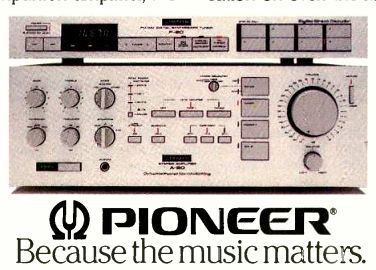
THE DIGITAL DIRECT DECODER TECHNOLOGY SO ADVANCED EVEN A HUMAN BEING CAN HEAR THE DIFFERENCE.
Most highly-touted, so-called technological breakthroughs are actually so subtle only a handful of people in the world can actually discern that there's a difference.
The rest of us, audiophiles and normal human beings alike, must be content to subtract the old specs from the new and assume there really is an audible difference.
But not with the F-90 tuner. A new tuner with design technology that High Fidelity says represents "..a stunning breakthrough in FM tuner performance thanks to a circuit it (Pioneer) calls a Digital Direct Decoder..."
Not only are the new F-90's specs remark ably superior to the naked eye, its sound quality and reception capabilities are unmistakably better to the naked ear.
Coupled with its companion amplifier, the A-90, you have a system that produces much cleaner, more musical sound. The kind of sound the musicians and recording engineers had in mind in the first place.
The reason is an exclusive, revolutionary new technology invented by Pioneer engineers. The Digital Direct Decoder is an unconventional circuit that uses a 1.26 MHz pulse train and a pure 38 KHz sine wave, thereby eliminating the need for a conventional noise filter (which creates distortion, harmonics, and limits frequency response).
Consequently, Total Harmonic Distortion at 1 KHz has been reduced to 0.0095% (mono) and 0.02% (stereo), which you'll have to agree is an exceptional improvement over conventional tuners. Signal-to-noise ratio is an astonishing 93dB (mono), 86dB (stereo).
Furthermore, alternate channel selectivity (always a nemesis and rarely exceeding 60dB before) has been raised significantly to 90dB at 80dBf, eliminating neighboring station "bleed over" once and for all.
And, whereas the better tuners available before produced stereo channel separation numbers no higher than 50dB, the F-90's numbers are up 30% to 65dB.
Suffice it to say, you can expect the same outstanding performance from our new A-90 integrated amplifier.
To begin with, there's 200 watts per channel of exceptionally dean power. (0.002% THD, 20-20,000 Hz at rated power, both channels driven, 8 ohms.) And signal-to-noise ratio is a superior 115dB that combines with the above numbers to get distortion levels that read at the level of immeasurability.
The reasons: our new dynamic power supply, non-switching amp circuits, an FET Buffer circuit, D.C. Servo circuit, and a new, higher specification on even the lowliest components.
Naturally, we recommend you audition both the F-90 and A-90 at your earliest convenience.
Because mere words can't describe a difference so remarkable it can actually be heard with your own two ears.

PIONEER® Because the music matters.
(Source: Audio magazine, Sept. 1981)
Also see:
Pioneer electronics "State-of-the-Art" (ad, Aug. 1981)
Pioneer electronics (ad, May 1974)
Pioneer CT-9R cassette deck (ad, Sept. 1981)
Pioneer PL-510 turntable (ad, May 1977)
= = = =